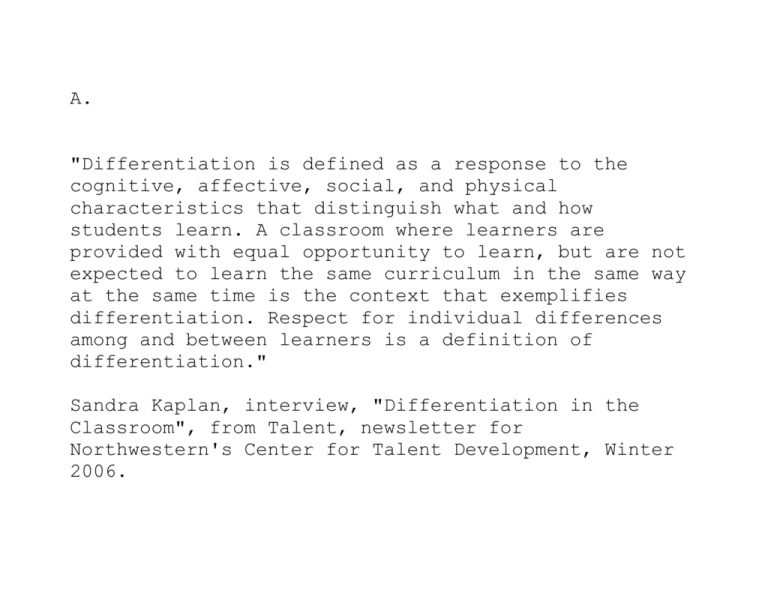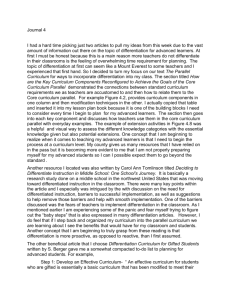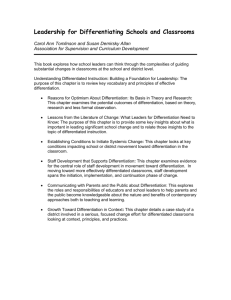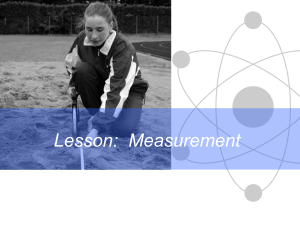DI quotes - Dare to Differentiate
advertisement

A. "Differentiation is defined as a response to the cognitive, affective, social, and physical characteristics that distinguish what and how students learn. A classroom where learners are provided with equal opportunity to learn, but are not expected to learn the same curriculum in the same way at the same time is the context that exemplifies differentiation. Respect for individual differences among and between learners is a definition of differentiation." Sandra Kaplan, interview, "Differentiation in the Classroom", from Talent, newsletter for Northwestern's Center for Talent Development, Winter 2006. B. "It is important for all educators to view differentiation as a philosophy and then to assess the manner and degree to which differentiation occurs within each classroom. It is also important to realize that teachers will vary along the lines of a continuum in their expertise in knowing how to differentiate in the teaching and learning environment. When educators have the time to study their content and to clarify what they want students to know, understand, and be able to do, I often find that the instructional tasks that they design become more meaningful and require students to think more deeply." Jan Leppein, interview, "Differentiation in the Classroom", from Talent, newsletter for Northwestern's Center for Talent Development, Winter 2006. C. "DI is mostly about what we do ahead of time, not how we interact or conduct the lesson at the time. There are some good aspects going on in the classroom, but that facilitation can only occur with purposeful and thoughtful planning. I can make flexible decisions because I've already prepared the resources or other avenues in anticipation of student needs. Am I always prepared for everything? No way. I get better with time, however." Rick Wormeli, MiddleWeb List Serve Response, "Getting Started with Differentiation", 2003. D. "When teachers effectively differentiate instruction, there is a continuous flow in the processes of teaching, learning, and assessment. These components operate not as steps that we follow, but rather as a continuous cycle, each process informing the next." Diane Heacox, Making Differentiation a Habit, 2009. E. "Differentiation is driven by 3 cogs: • The student seeks - challenge, affirmation, purpose, power, contribution • The teacher responds - investment, persistence, invitation, opportunity, reflection • The knowledge of the world - focused, engaging, demanding, scaffolded" Carol Tomlinson, NAGC Conference, November 2002 F. "What we share in common makes us human. How we differ makes us individuals. In a classroom with little or no differentiated instruction, only student similarities seem to take center stage. In a differentiated classroom, commonalities are acknowledged and built upon, and student differences become important elements in teaching and learning as well ....students have multiple options for taking in information, making sense of ideas, and expressing what they learn. In other words, a differentiated classroom provides different avenues to acquiring content, to processing or making sense of ideas, and to developing products." Tomlinson, Carol Ann. How to Differentiate Instruction in Mixed-Ability Classrooms, Association for Supervision and Curriculum Development, 1995 G. "What is important about differentiation? The important thing about differentiation is that it attempts to increase student achievement. The important thing about differentiation is that it is pro-active. The important thing about differentiation is that it demands the reconfiguration of various curriculum components. The important thing about differentiation is that it requires appropriate professional development, planning, classroom management, and changes in grouping arrangements. But the most important thing about curriculum differentiation is that it respects and responds to student differences." Jeanne Purcell, Deb Burns. "Capturing the Essence of Curriculum Differentiation". The Trillium. Ontario ASCD. June 2002 H. "If I'm (the teacher) doing a good job. You (the student) will be struggling appropriately. Define what is fair for each student. Fair is when each student is struggling enough to learn something new. A fair fit for one student will be different from the fair fit of another. A simple packaging for differentiation is this: put students in situations where they don't know the answer—often. " Dr. Carole Morreale, "Leadership For Gifted Education", IAGC graduate course, March 2000, Northwestern University. I. "It's what I am doing when I feel great about my teaching. I planned for the differences, I took into account what the kids were doing and what they had showing me they knew. I thought out how I would match up what I would ask them to do, which resources I would use for whom, and what kinds of questions I would ask of different kids." 4th grade teacher, Wilmette Public Schools, during teacher collaboration session, 2000. J. "I would like to propose that is a way of life. It can be studied; it can be analyzed but in order to be a truly “differentiated” teacher, you have to completely jump into the role. You don’t just differentiate this lesson or this product. You live a differentiated life. I bet you have experienced one of these teachers in your career. Think about that teacher and what they did. These are the teachers that although you are one of 150 that they see during the day, you feel they designed this lesson just for you. They are talking and questioning you, and everyone else is just along for the ride. That is a teacher who is differentiating...You have to live it, give your teaching self over to it. When it happens - what a freeing thing it is! Think about it, by providing opportunities for students to make choices and show their strengths, I do not have to constantly try and figure out what is best for every student. By providing an atmosphere of risk taking, every student can work to their potential – they are willing to risk stepping out of their comfort zone, and that is how growth takes place.." Laurie Westphal, blogger on Classroom 2.0~ What is DifferentiationReally? Classroom 2.0, Februrary 20, 2009 K. "If you were to fold your hands together naturally, you would have a comfortable, close fit. The goals of curriculum differentiation are to find the closest, most comfortable fit between the learner and the curriculum ...varying the process or content or product to match the needs of the learner can help us reach that close fit." Dr James Curry presenting January 21, 1999 at a District 39 presentation for parents of identified gifted students L. Teach me my most difficult concepts in my preferred style. Let me explore my easiest concepts in a different style. Just don’t teach me all the time in your preferred style and think I’m not capable of learning. – Virleen M. Carlson, Center for Learning and Teaching. M. I like this class because there’s something different going on all the time. My other classes, it’s like peanut butter for lunch every single day. This class, it’s like my teacher really knows how to cook. It’s like she runs a really good restaurant with a big menu and all. –5th grade student, in a comment from a course evaluation N. I really like DI classes because it makes me feel like I can do it. It doesn’t make me feel smart or dumb, big or small—It makes me feel important. – Meg, elementary school student O. Differentiation is making sure that the right students get the right learning tasks at the right time. Once you have a sense of what each student holds as “given” or “known” and what he or she needs in order to learn, differentiation is no longer an option; it is an obvious response. Lorna M. Earl, Assessment as Learning: Using Classroom Assessment to Maximize Student Learning, 2003







